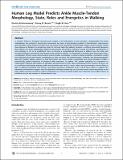Human Leg Model Predicts Ankle Muscle-Tendon Morphology, State, Roles and Energetics in Walking
Author(s)
Krishnaswamy, Pavitra; Brown, Emery Neal; Herr, Hugh M
DownloadKrishnaswamy-2011-Human Leg Model Pred.pdf (845.4Kb)
PUBLISHER_CC
Publisher with Creative Commons License
Creative Commons Attribution
Terms of use
Metadata
Show full item recordAbstract
A common feature in biological neuromuscular systems is the redundancy in joint actuation. Understanding how these redundancies are resolved in typical joint movements has been a long-standing problem in biomechanics, neuroscience and prosthetics. Many empirical studies have uncovered neural, mechanical and energetic aspects of how humans resolve these degrees of freedom to actuate leg joints for common tasks like walking. However, a unifying theoretical framework that explains the many independent empirical observations and predicts individual muscle and tendon contributions to joint actuation is yet to be established. Here we develop a computational framework to address how the ankle joint actuation problem is resolved by the neuromuscular system in walking. Our framework is founded upon the proposal that a consideration of both neural control and leg muscle-tendon morphology is critical to obtain predictive, mechanistic insight into individual muscle and tendon contributions to joint actuation. We examine kinetic, kinematic and electromyographic data from healthy walking subjects to find that human leg muscle-tendon morphology and neural activations enable a metabolically optimal realization of biological ankle mechanics in walking. This optimal realization (a) corresponds to independent empirical observations of operation and performance of the soleus and gastrocnemius muscles, (b) gives rise to an efficient load-sharing amongst ankle muscle-tendon units and (c) causes soleus and gastrocnemius muscle fibers to take on distinct mechanical roles of force generation and power production at the end of stance phase in walking. The framework outlined here suggests that the dynamical interplay between leg structure and neural control may be key to the high walking economy of humans, and has implications as a means to obtain insight into empirically inaccessible features of individual muscle and tendons in biomechanical tasks.
Date issued
2011-03Department
Harvard University--MIT Division of Health Sciences and Technology; Massachusetts Institute of Technology. Department of Brain and Cognitive Sciences; Massachusetts Institute of Technology. Media Laboratory; Program in Media Arts and Sciences (Massachusetts Institute of Technology)Journal
PLoS Computational Biology
Publisher
Public Library of Science
Citation
Krishnaswamy, Pavitra, Emery N. Brown, and Hugh M. Herr. “Human Leg Model Predicts Ankle Muscle-Tendon Morphology, State, Roles and Energetics in Walking.” Ed. Karl J. Friston. PLoS Computational Biology 7 (2011): e1001107.
Version: Final published version
ISSN
1553-7358
1553-734X